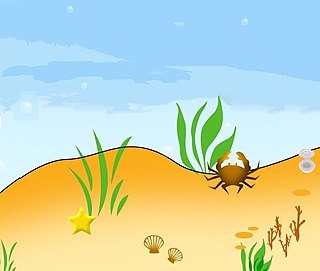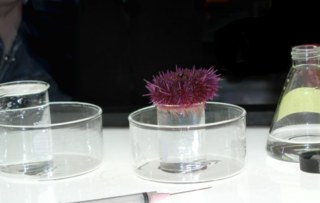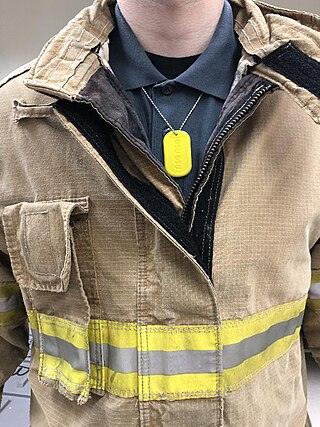Bioaccumulation is the gradual accumulation of substances, such as pesticides or other chemicals, in an organism. Bioaccumulation occurs when an organism absorbs a substance faster than it can be lost or eliminated by catabolism and excretion. Thus, the longer the biological half-life of a toxic substance, the greater the risk of chronic poisoning, even if environmental levels of the toxin are not very high. Bioaccumulation, for example in fish, can be predicted by models. Hypothesis for molecular size cutoff criteria for use as bioaccumulation potential indicators are not supported by data. Biotransformation can strongly modify bioaccumulation of chemicals in an organism.

Benthos, also known as benthon, is the community of organisms that live on, in, or near the bottom of a sea, river, lake, or stream, also known as the benthic zone. This community lives in or near marine or freshwater sedimentary environments, from tidal pools along the foreshore, out to the continental shelf, and then down to the abyssal depths.

Bivalvia, in previous centuries referred to as the Lamellibranchiata and Pelecypoda, is a class of marine and freshwater molluscs that have laterally compressed bodies enclosed by a shell consisting of two hinged parts. As a group, bivalves have no head and they lack some usual molluscan organs, like the radula and the odontophore. The class includes the clams, oysters, cockles, mussels, scallops, and numerous other families that live in saltwater, as well as a number of families that live in freshwater. The majority are filter feeders. The gills have evolved into ctenidia, specialised organs for feeding and breathing. Most bivalves bury themselves in sediment, where they are relatively safe from predation. Others lie on the sea floor or attach themselves to rocks or other hard surfaces. Some bivalves, such as the scallops and file shells, can swim. The shipworms bore into wood, clay, or stone and live inside these substances.

Water quality refers to the chemical, physical, and biological characteristics of water based on the standards of its usage. It is most frequently used by reference to a set of standards against which compliance, generally achieved through treatment of the water, can be assessed. The most common standards used to monitor and assess water quality convey the health of ecosystems, safety of human contact, extent of water pollution and condition of drinking water. Water quality has a significant impact on water supply and oftentimes determines supply options.

Environmental remediation deals with the removal of pollution or contaminants from environmental media such as soil, groundwater, sediment, or surface water. Remedial action is generally subject to an array of regulatory requirements, and may also be based on assessments of human health and ecological risks where no legislative standards exist, or where standards are advisory.
The National Ocean Service (NOS) is an office within the U.S. Department of Commerce, National Oceanic and Atmospheric Administration (NOAA). It is responsible for preserving and enhancing the nation's coastal resources and ecosystems along approximately 95,000 miles (153,000 km) of shoreline, that is bordering 3,500,000 square miles (9,100,000 km2) of coastal, Great Lakes and ocean waters. Its mission is to "provide science-based solutions through collaborative partnerships to address evolving economic, environmental, and social pressures on our oceans and coasts." The office works with partnered agencies to ensure that ocean and coastal areas are safe, healthy, and productive. It`s projects focus on working to ensure safe and efficient marine transportation, promoting the protection of coastal communities, conserving marine and coastal places. It employs 1,700 scientists, natural resource managers, and specialists in many different fields. The National Ocean Service was previously known as the National Ocean Survey until it was renamed in 1983.

Aquatic toxicology is the study of the effects of manufactured chemicals and other anthropogenic and natural materials and activities on aquatic organisms at various levels of organization, from subcellular through individual organisms to communities and ecosystems. Aquatic toxicology is a multidisciplinary field which integrates toxicology, aquatic ecology and aquatic chemistry.

Illahee State Park is an 82-acre (33 ha) Washington state park located in the hamlet of Illahee, just north of East Bremerton, on Port Orchard Bay, part of Puget Sound. The word "Illahee" means earth or country in the Native language Chinuk Wawa. The park was established when Kitsap County donated 13 acres to the state in 1934. The park's old-growth stand is home to one of the nation's oldest Pacific yews, which has been standing for approximately 400 years. Park activities include picnicking, camping, hiking, boating, and shellfish harvesting.

Aquatic biomonitoring is the science of inferring the ecological condition of rivers, lakes, streams, and wetlands by examining the organisms that live there. While aquatic biomonitoring is the most common form of biomonitoring, any ecosystem can be studied in this manner.

Castro Cove is a "portion of the San Pablo Bay" in Richmond, California located between Point San Pablo and the confluence of Wildcat Creek into Castro Creek.
Illahee is an unincorporated community in Kitsap County, Washington, United States, between Bremerton and Silverdale. It is home to Illahee State Park and other local parks. The word "Illahee" means earth or country in the Native language Chinuk Wawa.

Environmental monitoring describes the processes and activities that need to take place to characterize and monitor the quality of the environment. Environmental monitoring is used in the preparation of environmental impact assessments, as well as in many circumstances in which human activities carry a risk of harmful effects on the natural environment. All monitoring strategies and programs have reasons and justifications which are often designed to establish the current status of an environment or to establish trends in environmental parameters. In all cases, the results of monitoring will be reviewed, analyzed statistically, and published. The design of a monitoring program must therefore have regard to the final use of the data before monitoring starts.
In environmental toxicology, effects range low (ERL) and effects range median (ERM) are measures of toxicity in marine sediment. They are used by public agencies in the United States in formulating guidelines in assessing toxicity hazards, in particular from trace metals or organic contaminants.
Tissue residue is the concentration of a chemical or compound in an organism's tissue or in a portion of an organism's tissue. Tissue residue is used in aquatic toxicology to help determine the fate of chemicals in aquatic systems, bioaccumulation of a substance, or bioavailability of a substance, account for multiple routes of exposure, and address an organism's exposure to chemical mixtures. A tissue residue approach to toxicity testing is considered a more direct and less variable measure of chemical exposure and is less dependent on external environmental factors than measuring the concentration of a chemical in the exposure media.
A polar organic chemical integrative sampler (POCIS) is a passive sampling device which allows for the in situ collection of a time-integrated average of hydrophilic organic contaminants developed by researchers with the United States Geological Survey in Columbia, Missouri. POCIS provides a means for estimating the toxicological significance of waterborne contaminants. The POCIS sampler mimics the respiratory exposure of organisms living in the aquatic environment and can provide an understanding of bioavailable contaminants present in the system. POCIS can be deployed in a wide range of aquatic environments and is commonly used to assist in environmental monitoring studies.

Microtox is an in vitro testing system which uses bioluminescent bacteria to detect toxic substances in different substrates such as water, air, soils and sediments. Allivibrio fischeri are non-pathogenic, marine, bacteria that luminesce as a natural part of their metabolism. When exposed to a toxic substance, the respiratory process of the bacteria is disrupted, reducing light output. Allivibrio fischeri have demonstrated high sensitivity across a wide variety of toxic substances. Response to toxicity is observed as a change in luminescence, which is a by-product of cellular respiration. This change can be used to calculate a percent inhibition of Allivibrio fischeri that directly correlates to toxicity.
Equilibrium partitioning Sediment Benchmarks (ESBs) are a type of Sediment Quality Guideline (SQG) derived by the US Environmental Protection Agency (EPA) for the protection of benthic organisms. ESBs are based on the bioavailable concentration of contaminants in sediments rather than the dry-weight concentration. It has been demonstrated that sediment concentrations on a dry-weight basis often do not predict biological effects. Interstitial water concentrations, however, predict biological effects much better. This is true because the chemical present in the interstitial water (or pore water) is the uncomplexed/free phase of the chemical that is bioavailable and toxic to benthic organisms. Other phases of the chemical are bound to sediment particles like organic carbon (OC) or acid volatile sulfides (AVS) and are not bioavailable. Thus the interstitial water concentration is important to consider for effects to benthic organisms.
In aquatic toxicology, the sediment quality triad (SQT) approach has been used as an assessment tool to evaluate the extent of sediment degradation resulting from contaminants released due to human activity present in aquatic environments. This evaluation focuses on three main components: 1.) sediment chemistry, 2.) sediment toxicity tests using aquatic organisms, and 3.) the field effects on the benthic organisms. Often used in risk assessment, the combination of three lines of evidence can lead to a comprehensive understanding of the possible effects to the aquatic community. Although the SQT approach does not provide a cause-and-effect relationship linking concentrations of individual chemicals to adverse biological effects, it does provide an assessment of sediment quality commonly used to explain sediment characteristics quantitatively. The information provided by each portion of the SQT is unique and complementary, and the combination of these portions is necessary because no single characteristic provides comprehensive information regarding a specific site
SPMDs, or semipermeable membrane devices, are a passive sampling device used to monitor trace levels of organic compounds with a log Kow > 3. SPMDs are an effective way of monitoring the concentrations of chemicals from anthropogenic runoff and pollution in the marine environment because of their ability to detect minuscule levels of chemical. The data collected from a passive sampler is important for examining the amount of chemical in the environment and can therefore be used to formulate other scientific research about the effects of those chemicals on the organisms as well as the environment. Examples of commonly measured chemicals using SPMDs include: PAHs, PCBs, PBDEs, dioxins and furans as well as hydrophobic waste-water effluents like fragrances, triclosan and phthalates.

Passive sampling is an environmental monitoring technique involving the use of a collecting medium, such as a man-made device or biological organism, to accumulate chemical pollutants in the environment over time. This is in contrast to grab sampling, which involves taking a sample directly from the media of interest at one point in time. In passive sampling, average chemical concentrations are calculated over a device's deployment time, which avoids the need to visit a sampling site multiple times to collect multiple representative samples. Currently, passive samplers have been developed and deployed to detect toxic metals, pesticides, pharmaceuticals, radionuclides, polycyclic aromatic hydrocarbons (PAHs), polychlorinated biphenyls (PCBs), and other organic compounds in water, while some passive samplers can detect hazardous substances in the air.









